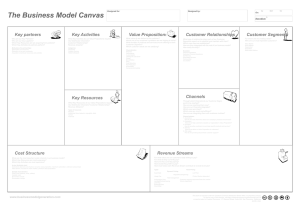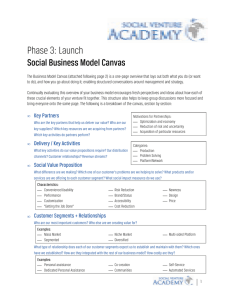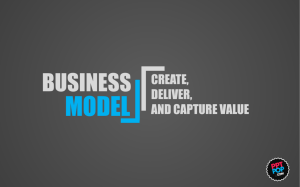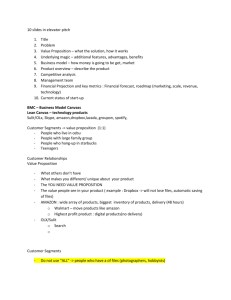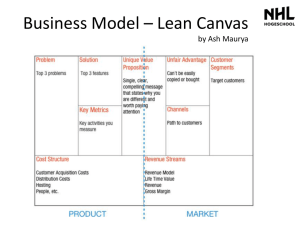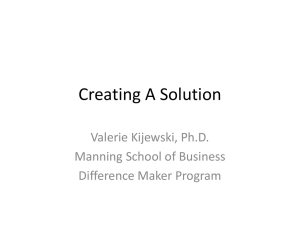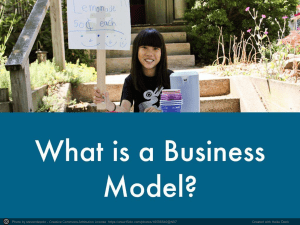SM & OC Presentation
advertisement
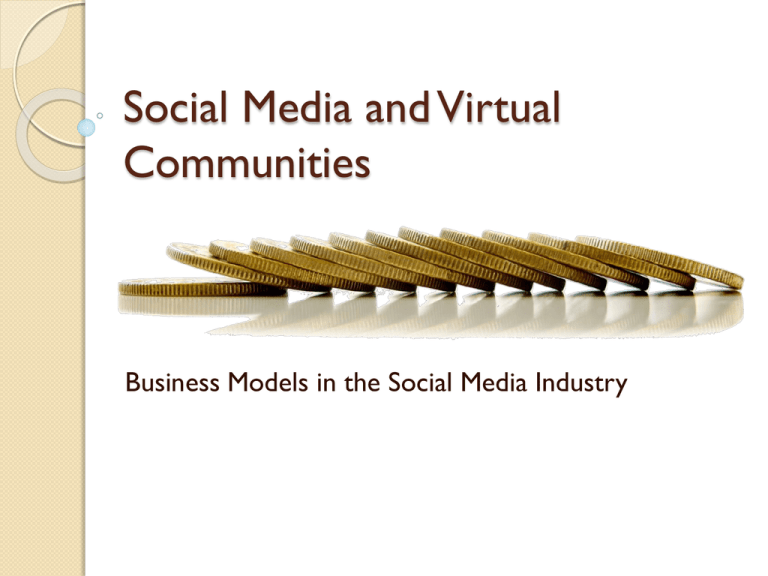
Social Media and Virtual Communities Business Models in the Social Media Industry Agenda The Business Model Canvas Business models of several social media services A (short) discussion: ◦ How to monetize a successful service? 2 The Business Model Canvas A general structure to the analysis of the business model of a social media service Must answer a few fundamental questions • The infrastructure on which the service is implemented • The value the service will generate • The customers • Financial issues revolving the business How ? What ? Who ? Money ? 3 Infrastructure What are the key resources we rely on to run our business model? How does each of these resources relate to: ◦ ◦ ◦ ◦ Our value propositions Their corresponding customer segments Channels Relationships 4 Partner Network Which partners could help us complement our value proposition? Which suppliers could help us streamline our business model? 5 Key Activities Are there activities we would better outsource to partners? Are our activities adapted perfectly to our value proposition? How could we streamline activities? 6 Key Resources Are there some key resources we could get rid of or substitute? Are there some key resources that could be better supplied by partners and cheaper? 7 Value Proposition What do we offer the market? What is the specific bundle of products and services we offer each of our customer segments? Which customer needs does each value proposition cover? Do we offer different service levels to different customer segments? 8 Value Proposition – Cont. Could we offer our different customer segments more tailored needs? Do our customers have other needs we could satisfy relatively easily by ourselves or with partners? Could we complement our value proposition through agreements with partners? ◦ Joint value propositions 9 Customer Relationships What level of personalization do each of our customer relationships require? ◦ Dedicated relationship manager ◦ Automated self-service How can we spend less time and resources on unprofitable clients? Should we introduce frequent buyer programs? 10 Customers & Distribution Channels Who do we create value for? Do any of these customers merit to be grouped into a distinct category, because: ◦ We propose them a distinct offer? ◦ We reach customers’ targets through different communication and distribution channels? ◦ We entertain different relationships with them? More personal ◦ They have a substantially different profitability? 11 Customers & Distribution Channels – Cont. Could we increase our customer base by better using our channels? How can we better use expensive channels for highly profitable clients and cost efficient channels for unprofitable clients? Can we better integrate our channels? ◦ Better link websites with physical outlets Could we introduce new communication and distribution channels to reach our customers? ◦ Partner distribution agreements 12 Customer Segments Are there new customer segments we could serve? Could we regroup/segment customers better according to their needs? 13 Revenue Streams Could we introduce new revenue streams? ◦ Lending/renting instead of selling Could we do more cross-selling? ◦ Offer our customers other products of our company or of partner companies 14 Cost Structure Are there ways we could reduce our cost structure? ◦ ◦ ◦ ◦ Partnering Outsourcing New suppliers Etc. 15 Business Model Canvas – The Interconnections Diagram HOW HOW- -Infrastructure Infrastructure WHAT – WHO WHO - Customer - Customer Product Key Activities Partner Network Customer Relationship Customer Segments WHAT - Offer Value Proposition Key Resources Distribution Channels Cost Structure Revenue Streams MONEY - Finance 16 Revenue Streams Split in the Social Media Industry Subscription Sale Advertisement No business model http://web2.wsj2.com 17 Subscription “Freemium” • Basic service for free, while charging for a premium service with advanced features to paying members. • Advantage: Allows incremental update of the service • Challenge: How much to give away for free so that users will still need and want to upgrade to a paying plan ? Fee-based business model • Pay a fee (generally monthly or yearly) to access a product or service • Advantage over one-off sale: creates a long term relationship with user (“addiction”) • Challenge: High value for money expectation Subscriptions help to create easy traction for the start-up http://mashable.com/2009/07/14/social-media-business-models/ 18 Advertisement Revenues through the sell of advertising locations. Classic trade-off between connexion volume and ad value. Main ad providers: Examples: MySpace,Youtube, Del.icio.us… Ads offer an easy source of revenues, but can be intrusive and are really viable for websites with large connection volumes. 19 20 Combinations are possible ! Yahoo! Add 21 Sale Pure sale Transaction-based • Pay for a product in the site • Real (Threadless) • Virtual (WoW, SL, Facebook) • Best exemplified by companies like eBay that charge for a given successful transaction Revenue sharing • Last.fm provides its users with the option to purchase the currently playing music from Amazon. Last.fm receives part of the revenue. 22 What if companies follow other goals ? • One of the most popular websites in the world • Poor financial condition due to culture of voluntariness and gratuitousness • No ads, no subscriptions, no affiliation program with PR agencies • Wikipedia is a social media NGO • Currently in severe financial problems. craigslist • “We really don't have a business model.” – Craig Newmark, Founder • Recruiters and employers in San Francisco, Los Angeles and New York are charged for classifieds. • Some companies pursue a pure growth-seeking strategy • Their goal is to create signal and public attention, and ultimately raise the interest of large investors. It is all about “creating something valuable in the first place” ! http://blogs.harvardbusiness.org/haque/2009/03/ideals.html 23 Services Grouped by Revenue Streams Model Subscription Sale Advertisement No business model http:// www.vtt.fi/inf/pdf/tiedotteet/2007/T2384.pdf 24 The Twitter Case: How to monetize tweets ? Features freemium model (charge for Keyword purchase (every tweet mentioning “Dominic Thomas” comes with a link to dominict.net + log of users posting keyword) video/pictures storage) Power user freemium model Sell data to 3rd party companies (charge for accounts with more than 1K followers) (working profile of users through contextual analysis of tweets) Merchandise (real and virtual Twitter goods) Cell-phone service provider (unlimited texting to 40404 plans) Advertising Charge for it ! Removead fee ! (every Xth tweet/on a right panel) Monetization can only make sense if it supports authentic, deep, value creation http://www.seomoz.org/blog/7-good-twitter-monetization-strategies-and-7-that-suck http://blog.twitter.com/2009/05/does-twitter-hate-advertising.html 25 http://mashable.com/2008/01/02/twitter-whats-the-best-business-model/ 26



